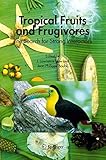Tropical Fruits and Frugivores : The Search for Strong Interactors / edited by J. Lawrence Dew, Jean Philippe Boubli.
Tipo de material: TextoEditor: Dordrecht : Springer Netherlands, 2005Descripción: vI, 260 páginas recurso en líneaTipo de contenido:
TextoEditor: Dordrecht : Springer Netherlands, 2005Descripción: vI, 260 páginas recurso en líneaTipo de contenido: - texto
- computadora
- recurso en línea
- 9781402038334
- QK900-989
Springer eBooks
Introduction: Frugivory, Phenology, and Rainforest Conservation -- Do Frugivore Population Fluctuations Reflect Fruit Production? Evidence from Panama -- Potential Keystone Plant Species for the Frugivore Community at Tinigua Park, Colombia -- Floristics, Primary Productivity and Primate Diversity in Amazonia: Contrasting a Eutrophic Várzea Forest and an Oligotrophic Caatinga Forest in Brazil -- A 12-Year Phenological Record of Fruiting: Implications for Frugivore Populations and Indicators of Climate Change -- An Intersite Comparison of Fruit Characteristics in Madagascar: Evidence for Selection Pressure Through Abiotic Constraints Rather Than Through Co-Evolution -- The Key to Madagascar Frugivores -- Fruiting Phenology and Pre-dispersal Seed Predation in a Rainforest in Southern Western Ghats, India -- Fast Foods of the Forest: The Influence of Figs on Primates and Hornbills Across Wallace’s Line -- The Frugivore Community and the Fruiting Plant Flora in a New Guinea Rainforest: Identifying Keystone Frugivores -- Diet, Keystone Resources and Altitudinal Movement of Dwarf Cassowaries in Relation to Fruiting Phenology in a Papua New Guinean Rainforest -- Keystone Fruit Resources and Australia’s Tropical Rain Forests.
In this book we undertake one of the first global-scale comparisons of the relationships between tropical plants and frugivorous animal communities, comparing sites within and across continents. In total, 12 primary contributors, including noted plant and animal ecologists, present newly-analyzed long-term datasets on the floristics and phenological rhythms of their study sites, identifying important seed dispersers and key plant taxa that sustain animal communities in Africa, Madagascar, Australasia, and the Neotropics.
Para consulta fuera de la UANL se requiere clave de acceso remoto.


